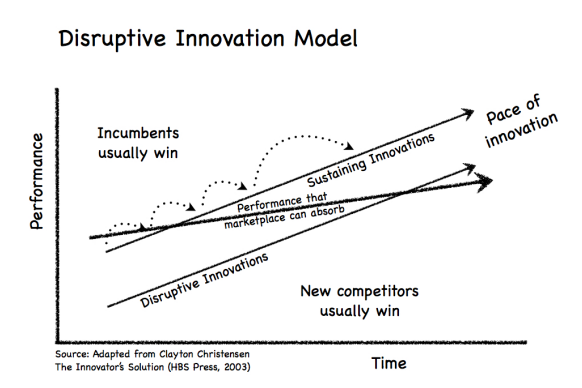
Disruptive Innovation!! The term disruptive innovation was coined by professor, author and entrepreneur Clay Christensen. Let us first get to know and understand what is the real concept behind an idea being disruptive. What acts as a catalyst for disruptive innovation? Is it Technology? Cost? Models? Services? Markets? All of them? No. Did I hear ‘Diversity’. Well, darn right. Fundamental thinking to stimulate innovation through diversity and collaboration by design is a potential strategy to pursue opportunities for disruptive innovations.
Disruptive Innovation – Theory
A disruptive idea is one that creates a brand new market and creates its own value network. Start-up disruption is a situation where an industry is completely shaken up and an established enterprise wobbles. This leads to disruption of the existing markets and networks. An established venture usually focuses more on improving its profitability and customer retention. While doing so, they overlook innovation. Disruptive ideas are generally outcomes of such ignorance.
“Probable impossibilities are to be preferred to improbable possibilities.” – Aristotle

A small group favorably targets one of the neglected segments and starts building a niche by delivering a more suited product, typically at a lower price. Start-ups get more time on rethinking where they don’t have to reinvent the wheel. With time the start-up delivers the performance that both the un-served customers as well as the mainstream customers need while improving on the overlooked aspects of the established venture. We can state disruption has occurred when the loyal customers of the established venture adopt the new entrant’s offerings. Based on Mr. Christensen’s theory, it is an innovation that transforms an existing market or sector by introducing simplicity, convenience, accessibility, and affordability where complication and high cost are the status quo.
An Idea/Innovation Is Disruptive Or Not?
Let’s consider the example of an iPod. The market was dominated by CDs when iPods were introduced. iPod’s feature was to store digitized music, thus making access and playback intuitive and trivial. The intended users were the mass market that wanted portable music. At the introduction, Steve Jobs put it as and how consumers might say it—“I carry my entire music collection in my pocket.” If we analyze the idea behind iPod, we can see that making music portable served an unmet need. By providing customers with something innovative and fulfilling a basic need iPod, indeed changed the course of the music industry. Thus, we can say it was a disruptive innovation.
The primary concept of a disruptive innovation is to learn how to predict the disruption potential of a product, service, or a business model and how to identify the key factors affecting the probability of disruption. Firstly, there is immense economic benefits of predicting the occurrence of probability of disruption. Secondly, based on the present market conditions, disruptive ideas have a higher potential of growth and dominating the market.

Methods used to make Disruptive Predictions
- Spotting an existing and addressable market scarcity
Firstly one should analyze and thoroughly study the behavior of an existing market for any sort of scarcity, then look for what can be improved and if a more sustainable product can be provided at a lesser price.
- Assessing unmet customers need
One should understand and discover which of the customer’s needs are unmet in a given market and act accordingly.
- Finding a solution for the scarcity
Once we have successfully identified an addressable scarcity, we assess the entire situation and come up with a solution.
- Allow the product to be viewed as inferior by the existing market incumbents
To capture the market with its disruptive idea, the new entrant must let the market leaders see it as not-required and ignore the product. This will help the new entrant disrupt when market leaders put down their guards and don’t realize the need to innovate themselves.
- Offer Price lesser than the market price
A probability of disruption is greater when the new product is better than the existing product and is available at a cheaper price than the market price.
- Be an outsider
When one is an outsider to the industry, he takes a baby step into the new industry, uses new technology and the outlook/perception is radically different from the already established ventures. Thus, improving the probability of disruption.
- Not using existing channels
If one uses the existing channels, then chances of resistance increases. Leaders may perceive the new product as a threat and take every possible measure to stop the product from reaching a customer.
- Offer multiple advantages over the existing product
The new product should offer multiple advantages over the existing product in terms of ease of use, flexibility, convenience and so on so forth.
Why Disruptive Works
The improvement cycle begins once the disruptive product gains a foothold in new or low-end markets. Because of the pace of technology is faster than customer’s ability to use it, the previously not-good-enough technology improves enough to intersect with the path of the more demanding customers. Disrupting has a paralyzing effect on industry leaders. They always tend to be motivated to go up-market and almost never motivated to defend the new or low-end markets that the disruptors find attractive.
A simple example could be an innovative way of preparing bread omelet which when tasted has an instant ‘Wow!! This is awesome…’ on their lips and they crave for more.











